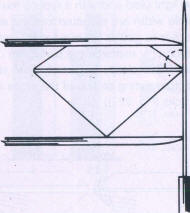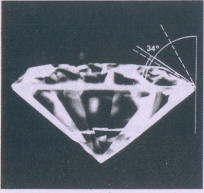 The
crown angle can be estimated visually with relative ease. Holding the
brilliant with the table and culet between the tweezers, a perpendicular
to the girdle is imagined, which can be confirmed with a needle or match
stick. It forms a right angle of 90° (Fig 223) with the plane of the
girdle. If one visually splits this right angle into three parts, then
the crown main facets should lie close above the first third = 34.5°
(Fig 224). If they lie considerably higher, the crown angle is clearly
too large, and the table is therefore larger than in the above case
(Fig 225). If the crown angle appears less than 30°, this results in a
smaller table.
The
crown angle can be estimated visually with relative ease. Holding the
brilliant with the table and culet between the tweezers, a perpendicular
to the girdle is imagined, which can be confirmed with a needle or match
stick. It forms a right angle of 90° (Fig 223) with the plane of the
girdle. If one visually splits this right angle into three parts, then
the crown main facets should lie close above the first third = 34.5°
(Fig 224). If they lie considerably higher, the crown angle is clearly
too large, and the table is therefore larger than in the above case
(Fig 225). If the crown angle appears less than 30°, this results in a
smaller table.
Inversely, from the measured values of the crown height and table size conclusions can be drawn as to the size of the angle. If the values lie within the given ratios the angle is correct at 34.5°. But if the table is too large in comparison with the crown height, the crown angle is larger than 34.5°, and vice versa.
 |
 |
| Fig 224 Crown angle about 1/3 of 90° = approx. 30° | Fig 225 Crown angle about 1/2 of 90° = approx 45° |
| Estimation of crown height | Girdle thickness |